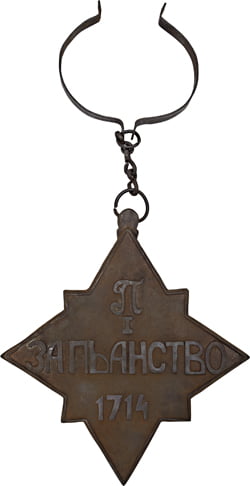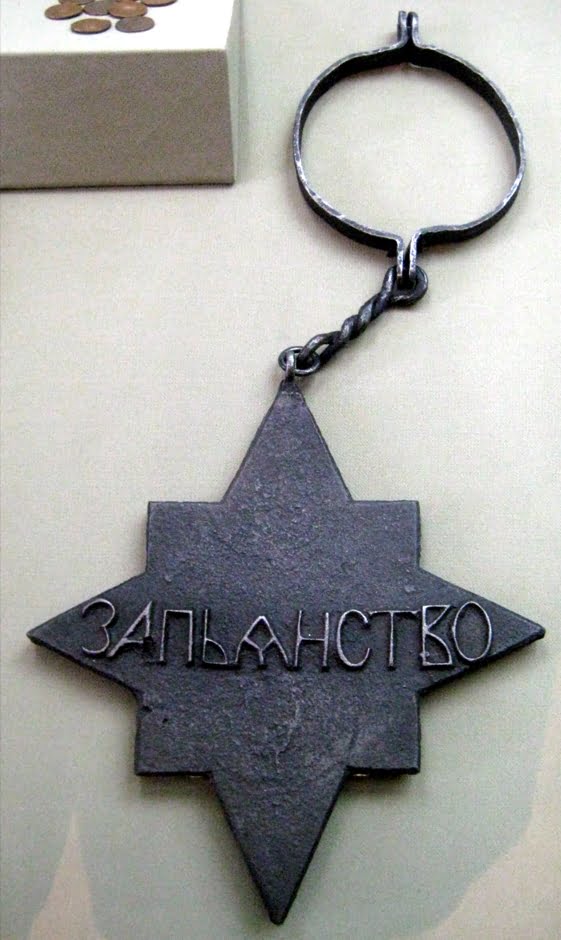In many books and media you can find a story about a very heavy medal, which the tsar allegedly awarded to alcoholics as punishment. We have verified the accuracy of this story.
In general terms, this unusual story goes something like this. Peter I was dissatisfied with drunkards and decided to wean them off their bad habit in a very original way. The Tsar allegedly ordered the casting of a cast iron medal weighing about 7 kg - it was put on a drunkard at the police station, and he was forced to wear this award from a week to a year. The medal “For Drunkenness” is mentioned in their texts by the authors of many major Russian publications, including “RIA Novosti", "Kommersant", "Rossiyskaya Gazeta", "Arguments and Facts", Lenta.ru, magazines Maxim And "Around the World". The authors of several popular science books also talk about the unusual award - for example, Andrey Galchuk in the collection “Amazing Russia. 500 facts about our country that will amaze you" and Valery Anishkin with Ekaterina Shmaneva in the book “Wealth and poverty of Tsarist Russia. Palace life of Russian tsars and the life of the Russian people". She is also mentioned by the writer Daniil Granin in the book "Quirks of Memory". The story has not spared social networks either—large public pages on VKontakte, for example, talk about it: "Science and Facts" (4.8 million subscribers), "The History of Humanity" (4.4 million), "5 interesting facts" (4.3 million), HistoryPorn (1.4 million) and many others. The award is also dedicated to a small article on Wikipedia.
Let's start with the fact that when studying publications mentioning the medal “For Drunkenness,” differences in the appearance of the award are striking. On some items we see the monogram of Peter I and a mention of 1714, on others these elements are not present. In some cases the ends of the star are more elongated, in others less. In one of the photographs the inscription “For drunkenness” is made in an arc, in others the letters are even (although sometimes the letter “B” is higher than the rest). In one of the cases, in place of the usual letter “I” there is the letter “Ѧ” (small yus), abolished under Peter I, in others - something more similar to the modern “A”. The shape of the fastener connecting the medal to the collar, the shape of the chain links and other details also differ.
Probably, a significant part of the images presented on the Internet are either photographs of modern souvenirs made “based on” a historical award, or amateur copies. In authoritative sources you can most often find one of two images.

Materials in major media about the medal “For drunkenness” (often together with this photograph) began to appear only at the end of 2013, they were illustrated by this photograph. Many of those publications were devoted to the news - the medal was put up for auction. In the catalog of the auction house "Znak" lot described like this: “Cast iron. Size 36 x 33 cm. The medal was made for the anniversary of the St. Petersburg Society for the Trusteeship of People's Sobriety in 1914. It exactly repeated the medal “For Drunkenness”, established by Peter I with the aim of fighting against drunkenness. Her weight was 17 pounds (about 7 kg). The medal was hung around the neck as a punishment for excessive drinking, so that it was impossible to remove it yourself. Considered the heaviest medal in history.” Despite the fact that we are talking about a copy of the early 20th century, and not an original, the medal with an initial cost of 45,000 rubles. went under the hammer for 220,000 rubles. According to Kommersant, the buyer became collector and founder of the Museum of the History of Corporal Punishment in Moscow Valery Pereverzev.
A significant number of earlier references are also associated with a variety of amateur museums. So, in 2011 (two years before the auction) the medal showed in a report by Channel One on the anniversary of the abolition of corporal punishment. The filming was carried out in the same Museum of the History of Corporal Punishment, the commentary was given by the same Valery Pereverzev, and two different medals “For Drunkenness” were shown in the frame. In 2009 the same award mentioned in a publication about the exhibition “Secrets of the Middle Ages” in Volzhsk, and in 2004 - in story about the Museum of Russian Vodka that opened in St. Petersburg. In 2018, the Demidov Merchants Memorial Museum in Tula presented a copy of the award with which any visitor could take a photo.

Of the large museums, as far as we were able to discover, the medal “For Drunkenness” is mentioned only by the State Historical Museum (GIM) in Moscow. There it is took a photo art critic Sofya Bagdasarova. The State Historical Museum often talks about this exhibit on social networks, and describes it differently at different times. So, in 2016, the State Historical Museum’s Facebook account reported: this “collar with a cast iron star with the inscription “For drunkenness”” weighing 4.1 kg was made in the first half of the 18th century, and was awarded to “workers of the Demidov factories.” This description matches the one Bagdasarova provided for the photograph on Wikimedia Commons in 2008. Moreover, in 2018 the museum was also on Facebook did another post in which the description of the medal acquired a “canonical” form: the award weighing 6.8 kg was introduced by Peter I in 1714 in order to fight against drunkenness, it was hung around the neck in the police station, and the medal had to be worn for a whole week. The same version of GIM outlined in a tweet in 2019. At the same time, in the catalog on the official website of the museum we failed discover such an exhibit.
We contacted the State Historical Museum with a request for comment; the press service forwarded our request to the metal department. Employees of this unit responded by sending a description of the exhibit from the museum catalog: “A collar with a cast-iron eight-pointed star and the inscription “For drunkenness.” According to the curators, the item entered the collection in 1930 from the Military History Museum and was made in the second half of the 1710s from iron and cast iron, its weight is 4.1 kg. Also, in the response from the metal department of the State Historical Museum, the Wikipedia article about the medal “For Drunkenness” was fully quoted, which sets out the widespread version of the decree of Peter I. Our interlocutors did not give any explanations about the connection between the exhibit and the content of the article. State Historical Museum employees did not answer clarifying questions, limiting themselves to the statement that they are not involved in “publishing information about objects on Facebook.”

Earlier mentions of the unusual award can be found in several Soviet-era sources. So, in 1988 about the medal “For Drunkenness” told in the literary and artistic magazine "Baikal". In 1972 her mentioned in the collection “Agriculture of Kyrgyzstan”, and a year earlier - in work "Soviet administrative legislation guarding public order." Let us note that these texts were not prepared by professional historians, and we were unable to find confirmation in academic publications.
The earliest mention of the medal as an award introduced by Peter I that we could find dates back to February 1965. Then in the magazine “Ogonyok” in the section “Funny little things” appeared a small note signed by V. Kogan: “Recently, while working on archival materials, I noticed an unusual medal. It turns out that under Peter I, drunkards who ended up in prison were hung around their necks with a cast-iron medal weighing 17 pounds (6.8 kg) with the inscription: “For drunkenness.” The text was accompanied by an image of the award—either a drawing or a photograph of poor quality.
At the same time, nothing is said about the seven-kilogram award in the pre-revolutionary texts available to us, as well as in the academic studies we studied. There is no decree or any other document on the establishment of the medal “For Drunkenness” as in "Complete collection of laws of the Russian Empire", and in the collection "Legislative acts of Peter I", prepared at the USSR Academy of Sciences. According to researchers, the king, on the contrary, encouraged the sale of alcoholic beverages - due to this, the treasury was replenished. Moreover, excessive drunkenness while on duty was punished much more severely than wearing a very heavy medal.
The origins of last year's unusual award studied our colleague Alexey Boronenko. Candidate of Historical Sciences Andrei Zakharov, to whom he turned for comment, stated that “nowhere, in any historical sources, is such a medal mentioned,” and hypothesized that “it could have been a one-time joke, which was then exaggerated.” In the exhibition of the State Historical Museum, according to Boronenko, this exhibit is displayed as a medal that was hung up by workers at the Demidov factories. Museum workers interviewed by our colleague reported that Peter I had nothing to do with this award. It was used “only on drunken workers: they had to wear it for a week, other workers had to laugh at them, and it was supposed to make drunkenness an unattractive habit.”
It is likely that the medal “For Drunkenness” existed in Peter’s time; the State Historical Museum’s employees are confident in the authenticity of the item itself. However, its existence was strictly local - a similar item was worn as punishment at the Demidov factories. In turn, the version that Peter I introduced a similar measure everywhere was first voiced only in the mid-1960s and is not confirmed by available historical sources and academic research. However, this did not prevent it from becoming popular, and the owners of numerous amateur museums from exhibiting medals that were quite different from each other, supposedly from the time of Peter I, under the guise of genuine artifacts.
Most likely not true
- Russian National Library. Complete collection of laws of the Russian Empire
- Arzamas. Law and order in Russia in the 18th century (course by Evgeniy AnisAndlanguage)
- I. Kurukin, E. Nikulina. “The sovereign’s tavern business”: essays on drinking policy and traditions in Russia
If you find a spelling or grammatical error, please let us know by highlighting the error text and clicking Ctrl+Enter.







